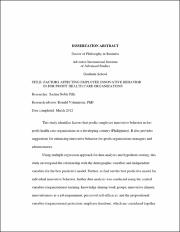Factors affecting employee innovative behavior in for-profit health care organizations
Abstract
This study identifies factors that predict employee innovative behavior in forprofit
health care organizations in a developing country (Philippines). It also provides
suggestions for enhancing innovative behavior for-profit organizations managers and
administrators.
Using multiple regression approach for data analysis and hypothesis testing, this
study investigated the relationship with the demographic variables and independent
variables for the best predictive model. Further, to find out the best predictive model for
individual innovative behavior, further data analysis was conducted using the control
variables (organizational learning, knowledge sharing work groups, innovative climate,
innovativeness as a job requirement, perceived self-efficacy), and the propositional
variables (organizational protection, employee freedom), which are considered together
as independent variables, on individual innovative behavior (dependent variable). Final
results showed that all the demographic variables were discarded because of insignificant
values and only 5 independent variables remained in the best predictive model of
individual innovative behavior.
A questionnaire survey was utilized to collect data regarding respondent’s
demographic information. A total of 987 questionnaires distributed, out of which 787
questionnaires were returned and 491 was the final usable questionnaires from health care
organizations in the Philippines completed the survey.
The results revealed that 42% of the variance in individual innovative behavior
can be explained by perceived self-efficacy, innovativeness as a job requirement,
innovative climate, employee freedom, and organizational learning. Perceived self efficacy
is the most important predictor, explaining 36% of the variance in individual
innovative behavior. Therefore, in order for organizations to improve their innovative
performance of their employees, it is recommended that they encourage, train, and
motivate employee in terms of their personal self-efficacy levels.


